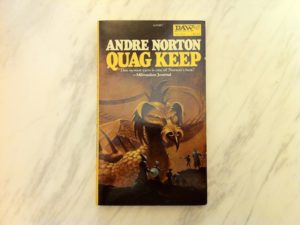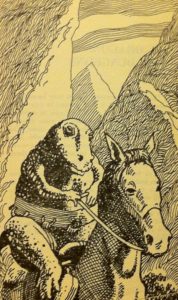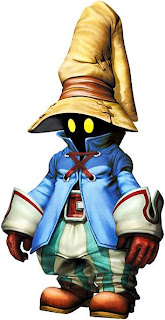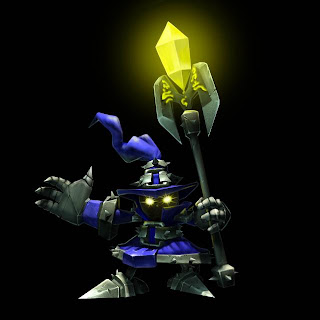 The plot of Quag Keep is terrible. TERRIBLE. Yes, so bad it’s worth the caps. So let’s just get that out of the way at the beginning. This book is interesting because it is one of the first (if not the first) published novels that is literally based on D&D and it is copyright 1978. It is set in Greyhawk. Gary Gygax is thanked explicitly in the beginning.
The plot of Quag Keep is terrible. TERRIBLE. Yes, so bad it’s worth the caps. So let’s just get that out of the way at the beginning. This book is interesting because it is one of the first (if not the first) published novels that is literally based on D&D and it is copyright 1978. It is set in Greyhawk. Gary Gygax is thanked explicitly in the beginning.
Why is the plot so bad? The main characters are under a wizard’s geas for the entire story. The text explains several times how they don’t have any choice about what they are doing. It’s like an explicit transcription of the worst kind of railroad plot. Further, there is a not entirely explained conceit that the characters are actually PCs being controlled by players in another world (that’s not a spoiler, there are hints about that on the first few pages, and the story begins in the “real world”). The party members all have magic bracelets with dice on them that spin when the characters encounter danger (and they can seemingly improve their odds by concentrating on the dice). From page 27:
“Those dice shall spin and their readings will control your movements–even as when you gamed. Your life, your death, your success, your failure, all shall be governed by their spin.” … “If you concentrate on the dice when they begin to spin, it is my belief that you will be able to change the score which will follow–though perhaps only by a fraction.”
There are a few things that can be salvaged though. The depiction of bard magic is good. The bard in the story really does pull out his harp and start strumming during combat (chapter 9 is titled “Harp Magic”). I think that a well designed bard class really needs its own mechanic instead of just being able to cast Vancian spells. Rather than being “fire and forget” spells, the bard’s songs are described more like sustained actions which provide continuing bonuses or penalties. From page 96:
There came a trilling of sound. At first Milo thought it isssued from the enemy, yet there was something in the sound that strengthened his courage, instead of increasing his doubts.
Wymarc had unbagged his harp. Now, as he swept his fingers back and forth across the strings, their mounts stood rock still. Music–against those!
…
Now there were no manlike bodies, only once more dark pools that heaved in a losing battle against what the bard had launched. Those pools flowed, joined. A single manifestation half arose. It formed no quasi-human body–rather suggested some monstrous shape. A toad head lifted for a moment, but could not hold, dissolving back into the mass. Yet the shadow thing continued to struggle, bringing forth a tentacle here–a taloned foot there. Then the heaving ceased. The pool of dark lay quiescent.
Wymarc lifted his hand from the harp strings. The pulsation of pain eased in his listeners. Milo heard Naile’s voice.
“Well done, songsmith! And how long will that spell hold? Or is the thing dead?”
“Do not grant me too much power, comrade. Like any spell, this has its limitations. We had better ride.”
And here is another (non-combat) example (page 99):
“You have shown us one magic, bard. But I do not think that is the limit of what you carry. Can you play ‘The Song of Far wings’?”
Wymarc’s hand went out to touch the harp bag which he kept ever within reach.
“I can. But to what purpose, ranger?”
“When we climb to the West Pass,” Ingrge returned, “we mist have a guide beyond if we seek Lichis. He has the will and power to hide himself from both men and elf; we cannot find him without some aid. It has been many years since any have hunted him. But he will feel our thoughts and strengthen his guard-spell unless we come to him by some way he has left unmarked, a way the feathered ones know.”
That is, a song to summon giant eagles for assistance. I kind of like the idea of bards wandering around adventuring in order to collect songs of power.
 My favorite part is the portrayal of Gulth the lizardman. Somehow Norton is able to make him endearing without really anthropomorphizing him. He really feels alien. He’s a swamp lizardman, so he is continuously drying out, and the other party members have to find ways to keep him damp, even when they venture out onto a dust sea with snow shoes. Tangent: perhaps this dust sea is a partial inspiration for the silt sea of Athas? Yes, I know, a sea of dust sound pretty cool, but even that is not enough to save this story. There is a nice frontispiece illustration of Gulth.
My favorite part is the portrayal of Gulth the lizardman. Somehow Norton is able to make him endearing without really anthropomorphizing him. He really feels alien. He’s a swamp lizardman, so he is continuously drying out, and the other party members have to find ways to keep him damp, even when they venture out onto a dust sea with snow shoes. Tangent: perhaps this dust sea is a partial inspiration for the silt sea of Athas? Yes, I know, a sea of dust sound pretty cool, but even that is not enough to save this story. There is a nice frontispiece illustration of Gulth.
Out of context bad quite from page 189:
The stranger was shaking his head. “You needn’t try to threaten me–you aren’t real, don’t you understand that? I’m the game master, the referee. I call the action! Oh–” He raised one had and rubbed his forehead. “This is ridiculous. Why do I argue with something–someone who does not really exist?”
Reading that gives me the same feeling as when I hear a really bad pun. It’s kind of fun to see the D&D classes explicitly in a story though (including a druid as monster). There party members include the elven ranger Ingrge, the wereboar berserker Naile Fangtooth (with pseudo-dragon pet), the previously mentioned lizardman Gulth, the “battlemaid” Yevele, the cleric Deav Dyne, the bard Wymarc, and the main character Milo Jagon (a human fighter). There was actually some mention of class level within the story as well, though I can’t find it right now.
At the very least, this novel also provided me with a nice name for a campaign world region: Quagland.







